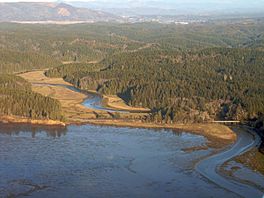Willapa Bay facts for kids
Quick facts for kids Willapa Bay |
|
|---|---|

Bone River flows into Willapa Bay's east side
|
|
| Location | Pacific Ocean |
| Coordinates | 46°39′44″N 124°0′38″W / 46.66222°N 124.01056°W |
| River sources | Bone River, Niawiakum River, Palix River, Naselle River, Bear River |
| Ocean/sea sources | Pacific Ocean |
| Basin countries | United States |
Willapa Bay is a large bay found on the southwest Pacific Ocean coast of Washington state in the United States. A long strip of land called the Long Beach Peninsula separates Willapa Bay from the huge Pacific Ocean. This bay is very big, covering over 260 square miles of water. It is the second-largest estuary on the Pacific coast of the United States. Long ago, early settlers called this bay Shoalwater Bay. You might still see this name on some old maps.
Contents
Discover Willapa Bay
Willapa Bay is quite shallow. More than half of its surface area is in the intertidal zone. This means it is covered by water at high tide and exposed to air at low tide. Also, half of the water in the bay flows in and out with every tide.
How Willapa Bay Formed
Willapa Bay is an estuary. An estuary is a place where fresh river water mixes with salty ocean water. It formed because the Long Beach Peninsula, a long sandy strip, partly closed off the mouths of several rivers. This peninsula was created by sand carried by the Columbia River to the south.
The bay is also a type of ria. A ria forms when sea levels rise and flood river valleys. This happened after the last ice age ended. The North River, Willapa River, and Naselle River bring most of the fresh water into the bay. Other rivers that flow into Willapa Bay include the Bone River, Niawiakum River, Palix River, Cedar River, and Bear River.
Towns Around the Bay
Several small towns and communities are located around Willapa Bay. Raymond and South Bend are both on the Willapa River. Other towns right on the bay include Oysterville, Nahcotta, Bay Center, and Tokeland. The entire bay is located within Pacific County, Washington.
Home to Oysters and Wildlife
Willapa Bay is famous for its local oyster and seafood industry. About 9% of all oysters grown in the U.S. come from this bay. The bay is also known for its amazing biodiversity, meaning it has many different kinds of plants and animals. Much of the bay, including all of Long Island, is part of the Willapa National Wildlife Refuge. This refuge protects the bay's natural environment.
The oyster beds in the bay are very helpful for the ecosystem. They provide homes for many creatures and help filter the water. This makes the water cleaner and healthier for everyone.
Protecting the Bay's Nature
In the 1990s, the bay's environment faced a challenge. A non-native grass called Atlantic cordgrass (Spartina alterniflora) started spreading very quickly. This grass was possibly brought in by accident, perhaps as packing material with oysters from the East Coast. It could also have been introduced to help protect wetlands.
To protect the bay, the State of Washington began spraying a special herbicide around 2005. This herbicide is believed to be safe for other plants and animals. Thanks to these efforts, the threat from the Spartina grass is now much smaller.


